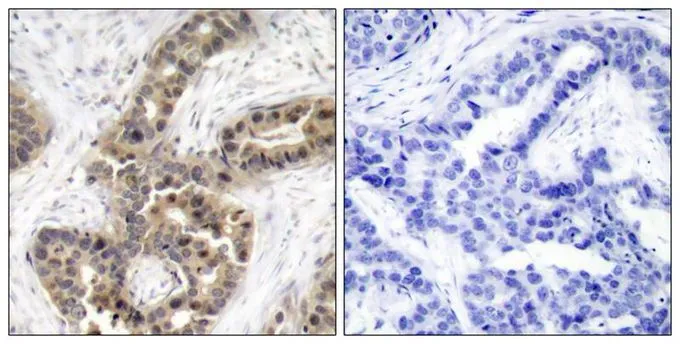p21 Cip1 antibody [GT1032]
GTX629543
ApplicationsFlow Cytometry, ImmunoFluorescence, ImmunoPrecipitation, Western Blot, ImmunoCytoChemistry, ImmunoHistoChemistry, ImmunoHistoChemistry Paraffin
Product group Antibodies
TargetCDKN1A
Overview
- SupplierGeneTex
- Product Namep21 Cip1 antibody [GT1032]
- Delivery Days Customer9
- Application Supplier NoteWB: 1:500-1:3000. ICC/IF: 1:100-1:1000. IP: 1:100-1:500. *Optimal dilutions/concentrations should be determined by the researcher.Not tested in other applications.
- ApplicationsFlow Cytometry, ImmunoFluorescence, ImmunoPrecipitation, Western Blot, ImmunoCytoChemistry, ImmunoHistoChemistry, ImmunoHistoChemistry Paraffin
- CertificationResearch Use Only
- ClonalityMonoclonal
- Clone IDGT1032
- Concentration0.8 mg/ml
- ConjugateUnconjugated
- Gene ID1026
- Target nameCDKN1A
- Target descriptioncyclin dependent kinase inhibitor 1A
- Target synonymsCAP20; CDK-interacting protein 1; CDK-interaction protein 1; CDKN1; CIP1; cyclin-dependent kinase inhibitor 1; cyclin-dependent kinase inhibitor 1A (p21, Cip1); DNA synthesis inhibitor; MDA-6; melanoma differentiation associated protein 6; P21; p21CIP1; SDI1; WAF1; wild-type p53-activated fragment 1
- HostMouse
- IsotypeIgG2a
- Protein IDP38936
- Protein NameCyclin-dependent kinase inhibitor 1
- Scientific DescriptionThis gene encodes a potent cyclin-dependent kinase inhibitor. The encoded protein binds to and inhibits the activity of cyclin-CDK2 or -CDK4 complexes, and thus functions as a regulator of cell cycle progression at G1. The expression of this gene is tightly controlled by the tumor suppressor protein p53, through which this protein mediates the p53-dependent cell cycle G1 phase arrest in response to a variety of stress stimuli. This protein can interact with proliferating cell nuclear antigen (PCNA), a DNA polymerase accessory factor, and plays a regulatory role in S phase DNA replication and DNA damage repair. This protein was reported to be specifically cleaved by CASP3-like caspases, which thus leads to a dramatic activation of CDK2, and may be instrumental in the execution of apoptosis following caspase activation. Two alternatively spliced variants, which encode an identical protein, have been reported. [provided by RefSeq]
- Storage Instruction-20°C or -80°C,2°C to 8°C
- UNSPSC12352203
References
- Hyperforin Elicits Cytostatic/Cytotoxic Activity in Human Melanoma Cell Lines, Inhibiting Pro-Survival NF-kappaB, STAT3, AP1 Transcription Factors and the Expression of Functional Proteins Involved in Mitochondrial and Cytosolic Metabolism.Read more
- Therapeutic effect of induced pluripotent stem cell -derived extracellular vesicles in an in vitro and in vivo osteoarthritis model.Read more
- CRISPR-mediated knockout of VEGFR2/KDR inhibits cell growth in a squamous thyroid cancer cell line. Tsai ML et al., 2022 May, FEBS Open BioRead more
- Salviolone from Salvia miltiorrhiza Roots Impairs Cell Cycle Progression, Colony Formation, and Metalloproteinase-2 Activity in A375 Melanoma Cells: Involvement of P21(Cip1/Waf1) Expression and STAT3 Phosphorylation. Zanr V et al., 2022 Jan 20, Int J Mol SciRead more
- Metformin Potentiates the Anticancer Effect of Everolimus on Cervical Cancer In Vitro and In Vivo. Chen YH et al., 2021 Sep 14, Cancers (Basel)Read more
- Chronic exposure to Cytolethal Distending Toxin (CDT) promotes a cGAS-dependent type I interferon response. Pons BJ et al., 2021 Sep, Cell Mol Life SciRead more
- Molecular Hydrogen Attenuated N-methyl-N-Nitrosourea Induced Corneal Endothelial Injury by Upregulating Anti-Apoptotic Pathway. Li R et al., 2021 Jul 1, Invest Ophthalmol Vis SciRead more
- Platelet-Derived Growth Factor Receptor-alpha Subunit Targeting Suppresses Metastasis in Advanced Thyroid Cancer In Vitro and In Vivo. Lin CL et al., 2021 Sep 1, Biomol Ther (Seoul)Read more
- Synergistic Anticancer Effects of Gemcitabine with Pitavastatin on Pancreatic Cancer Cell Line MIA PaCa-2 in vitro and in vivo. Chen YH et al., 2020, Cancer Manag ResRead more
- T1-11, an adenosine derivative, ameliorates aging-related behavioral physiology and senescence markers in aging mice. Hsu WH et al., 2020 Jun 5, Aging (Albany NY)Read more





![IHC-P analysis of squamous cell carcinoma tissue using GTX01859 p21 Cip1 antibody [4D10].](https://www.genetex.com/upload/website/prouct_img/normal/GTX01859/GTX01859_20200811_IHC-P_66_w_23053121_557.webp)
![IHC-P analysis of human urothelial carcinoma section using GTX02619 p21 Cip1 antibody [CIP1/2275R].](https://www.genetex.com/upload/website/prouct_img/normal/GTX02619/GTX02619_20210319_IHC-P_w_23053122_613.webp)